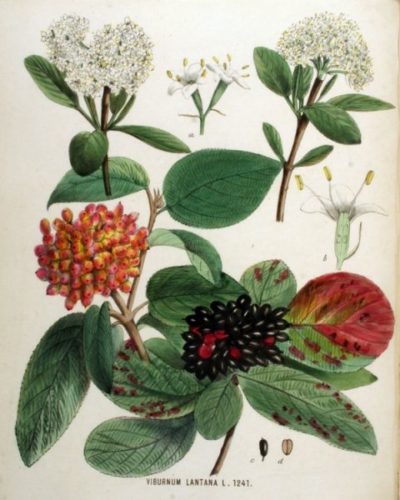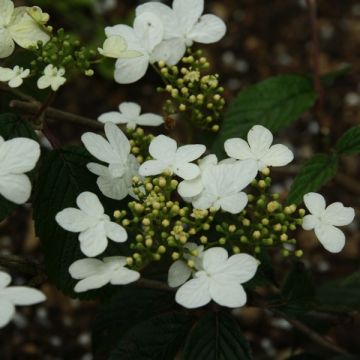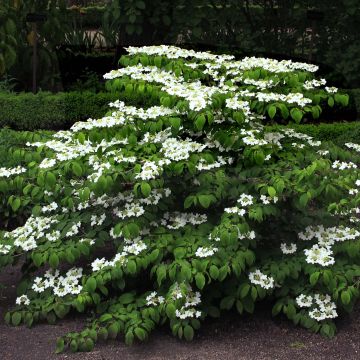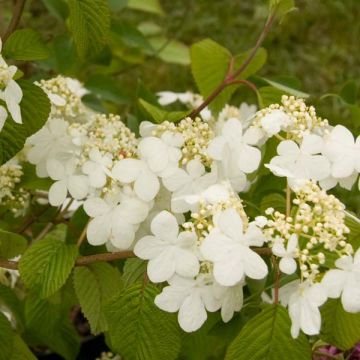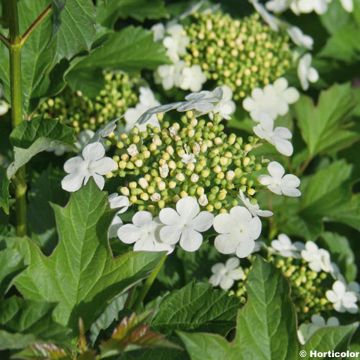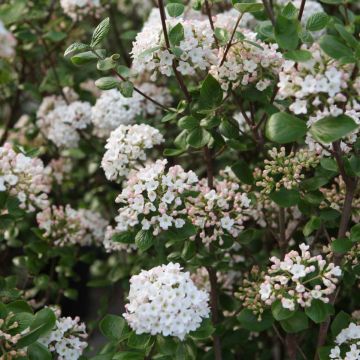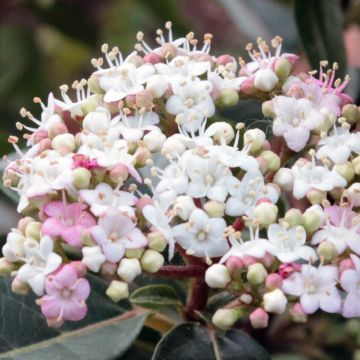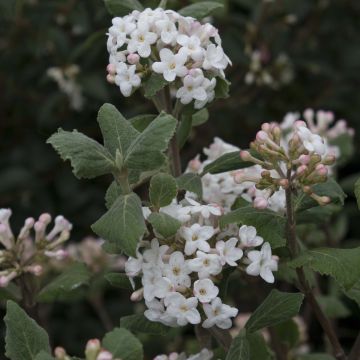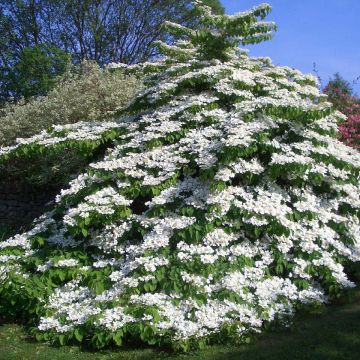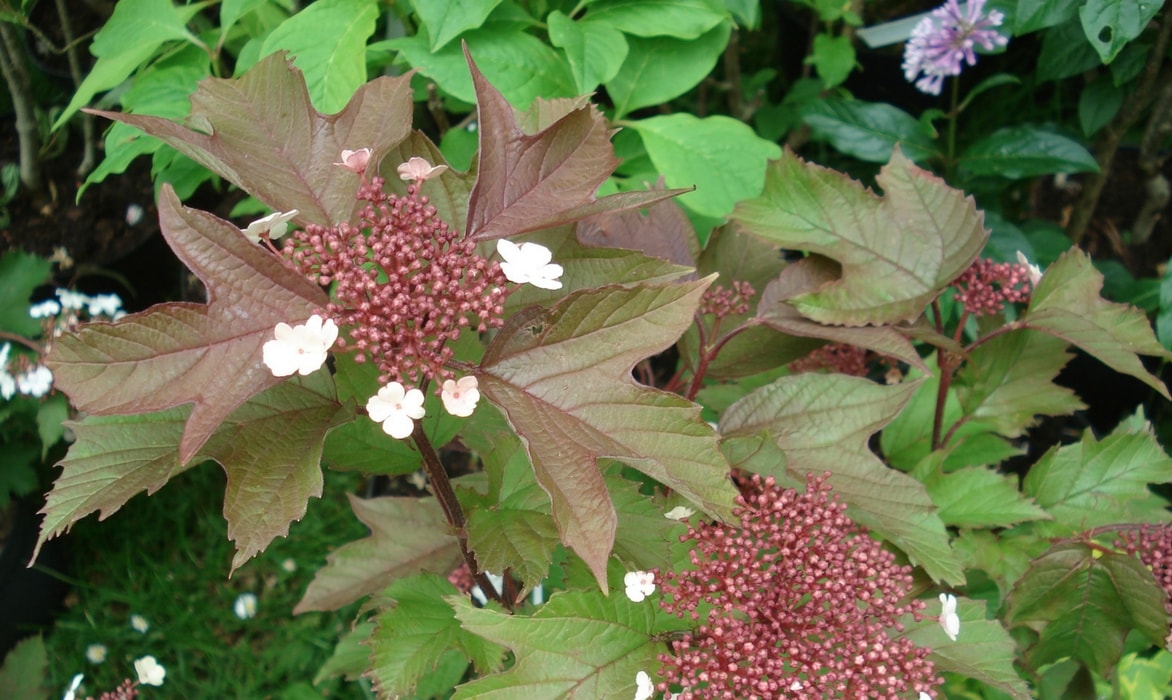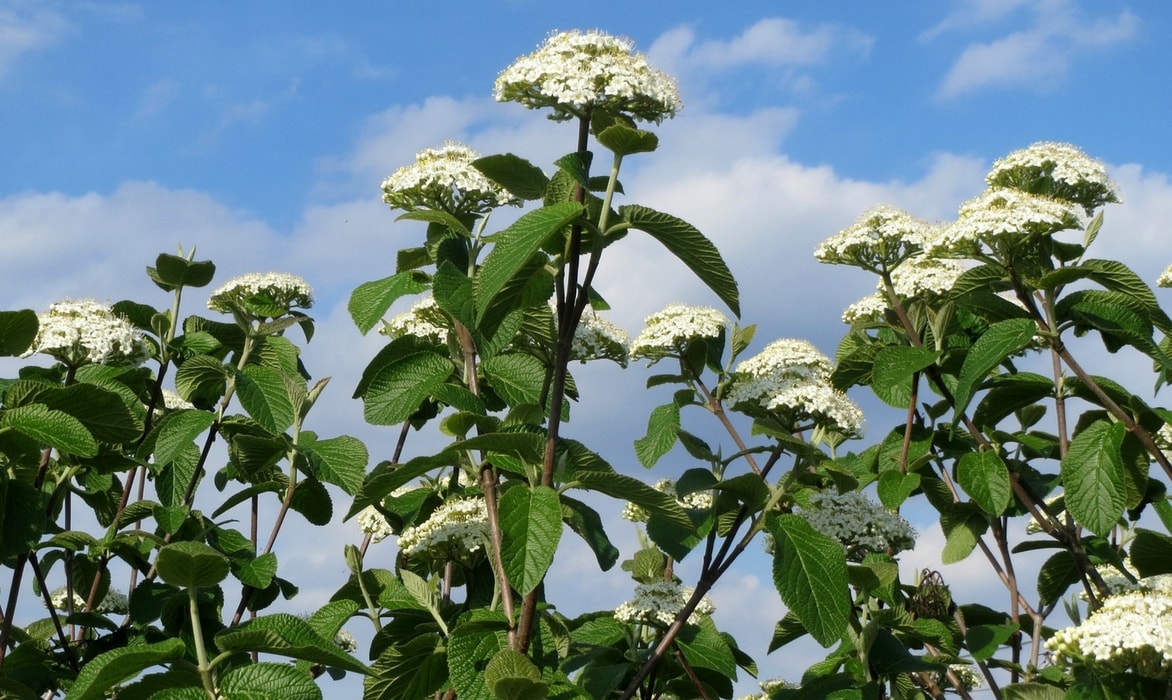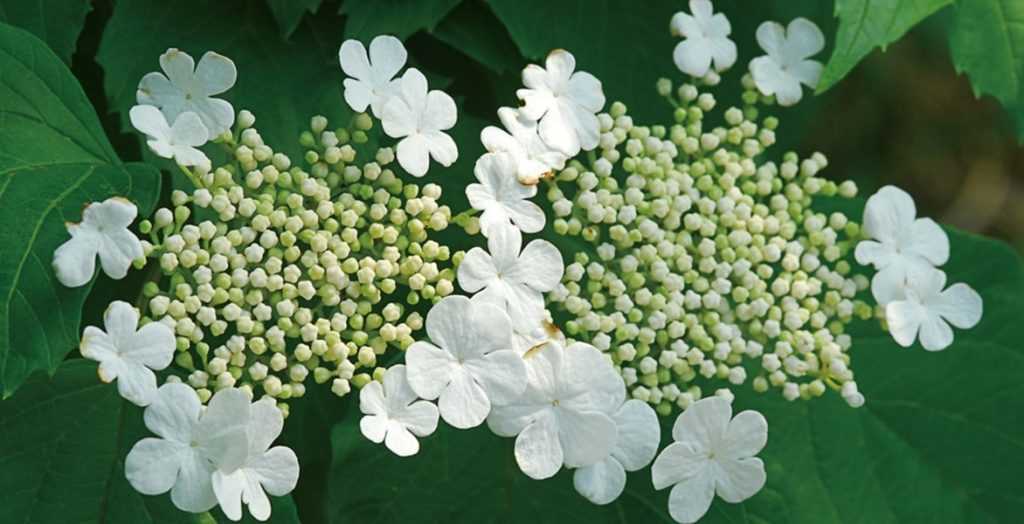
Viburnum: Planting, Pruning and Growing Guide
Contents
The Viburnum in a nutshell
- Viburnum has everything to please: abundant flowering, decorative berries, and foliage that turns beautiful shades in autumn, sometimes even evergreen! It’s interesting in every season.
- It thrives in all gardens: grow Viburnum tinus (Laurustinus) as a hedge or in pots, Viburnum plicatum as a standalone specimen, and Viburnum opulus (Guelder Rose, Snowball Tree) in flower beds.
- With its winter or spring flowering, Viburnum helps lift the gloom and grey of winter!
- It offers abundant blooms in soft hues, white with hints of pink, sometimes resembling snowballs.
- Very hardy and easy to grow, it requires little maintenance!
Our Expert's Word
Decorative with their delicate blooms, colourful berries, and foliage—which often takes on stunning autumn hues—Viburnums have it all! In winter or spring, they adorn flowerbeds with their generous white or blush-pink blossoms. Once flowering ends, red, black, or blue berries create fresh garden appeal and attract birds. Come autumn, the leaves of deciduous species turn magnificent shades of red or orange, as seen in Viburnum opulus (Guelder Rose), Viburnum lantana, and Viburnum plicatum. Meanwhile, evergreen species like Viburnum tinus (Laurustinus), Viburnum davidii, or Viburnum rhytidophyllum retain their foliage, remaining decorative in winter! Planted as hedges, they form a lush screen to shield against prying eyes during the colder months.
Fairly easy to grow, Viburnums require minimal maintenance. Most are highly hardy and thrive in full sun or partial shade. They prefer rich, moist, well-drained soil but generally adapt to most soil types, favouring slightly acidic conditions. Particularly pollution-resistant—especially Viburnum opulus, Viburnum tinus, and Viburnum davidii—they’re ideal for urban or polluted environments.
Viburnum tinus ‘Eve Price’ or Viburnum lantana work perfectly in a mixed hedge alongside other deciduous or evergreen shrubs! Meanwhile, Viburnum plicatum and Viburnum opulus ‘Roseum’ (also known as Snowball Tree) boast such spectacular blooms that they make striking standalone specimens—planted, for example, in the middle of a lawn. Other species can be used to create a vibrant shrub border.
Botany
Botanical data
- Latin name Viburnum sp.
- Family Adoxaceae
- Common name Viburnum
- Flowering winter or spring
- Height 1 to 5 m
- Exposure sun or partial shade
- Soil type humus-rich, moist, well-drained
- Hardiness -15 to -20°C for most species, and -10°C for Viburnum tinus
Viburnums comprise nearly 200 shrub species, as well as a few trees. The most well-known are probably the Laurustinus (Viburnum tinus) or the Guelder-rose (Viburnum opulus, also called Snowball tree). They are valued for their spring or winter flowering, decorative berries and foliage, which can take on beautiful autumn hues.
They now belong to the Adoxaceae family, a small family that includes elders. But they were previously classified in the Caprifoliaceae family, with Honeysuckle (botanists love change!). Viburnums are native to temperate regions of the Northern Hemisphere (Asia, Europe, North America). Many species are found in Asia, mainly in China, such as Viburnum davidii. The Guelder-rose (Viburnum opulus), the Wayfaring tree (Viburnum lantana) and Laurustinus (Viburnum tinus) grow naturally in France. The Guelder-rose is found in damp forests and hedgerows, while the Laurustinus originates from the Mediterranean region.

Viburnum inflorescence, fruiting and foliage
The name Viburnum is thought to come from the Latin viere, meaning to weave or bind, as the branches are flexible and can be used for weaving. The Wayfaring tree (Viburnum lantana) can thus be used in basketry.
Most Viburnums form bushes ranging in height from two to four metres. Some, like Viburnum lantana, can even reach five metres tall. There are also dwarf varieties, such as Viburnum opulus ‘Compactum’, or Viburnum davidii: very handy if you’re short on space in your garden! With its low, spreading habit, Viburnum davidii can be used as ground cover. The Chinese Viburnum, Viburnum plicatum, has horizontal branches that give it a remarkable tiered habit.
Many species flower in spring (mostly in May and June): this is the case for Viburnum lantana, Viburnum davidii, Viburnum plicatum, Viburnum opulus, Viburnum x burkwoodii, and Viburnum rhytidophyllum. As for Viburnum x bodnantense and Viburnum tinus (Laurustinus), they flower in winter, usually between December and March, sometimes as early as November for the latter. They help us wait for spring by bringing their delicate blooms to the garden when it’s most lacking in flowers!
Viburnum flowers have a very pure and soft hue. They are white, more or less tinged with pink. Gathered in large flat inflorescences – reminiscent of Hydrangeas – or spherical, they take on the appearance of snowballs! This is the case with Viburnum opulus, also nicknamed Snowball tree. These inflorescences bring together a multitude of small five-lobed flowers. They are very slightly fragrant. Some species, however, are known for their powerful fragrance: this is the case with Viburnum carlcephalum and Viburnum x burkwoodii. The flowers are nectar-rich and attract pollinating insects.
Viburnums have simple leaves, with often very marked veins. The leaf edges are sometimes toothed. The Guelder-rose (Viburnum opulus) is remarkable for its superb three-lobed leaves! Those of Viburnum rhytidophyllum are surprising for their wrinkled, embossed appearance, due to their extremely pronounced veins!
The foliage is deciduous in Viburnum bodnantense, Viburnum plicatum, Viburnum opulus and Viburnum lantana, and takes on magnificent autumn hues, often red, orange or purple. It is semi-evergreen in Viburnum ‘Le Bois Marquis’ or V. hilieri ‘Winton’, whose foliage regenerates in spring with beautiful bronze colours in spring then dark green in summer, finishing copper-red in winter. As for the evergreen species, they allow you to create a bed that stays green even in mid-winter! This is the case with Viburnum tinus, Viburnum davidii, Viburnum x burkwoodii and Viburnum rhytidophyllum. Also discover the superb golden yellow foliage of Viburnum lantana ‘Aureum’!
After flowering, Viburnums are adorned with decorative berries. They are generally red or blue and sometimes turn black when ripe. They will attract birds to the garden! Viburnum opulus ‘Xanthocarpum’ is a variety prized for its superb bright yellow berries. To encourage fruiting, group several plants of the same species together, especially if you’re planting Viburnum davidii, which is dioecious.
Most Viburnums are perfectly hardy. This is the case, for example, with Viburnum opulus, Viburnum x bodnantense and Viburnum rhytidophyllum, which can withstand temperatures as low as -20°C. The Laurustinus (Viburnum tinus) is the least hardy species: down to -10°C.
Discover the superb Viburnum hilieri ‘Winton’ in video:
Species and varieties of Viburnum
There are nearly 200 species and 300 varieties of Viburnum. The botanical species are commonly used for their ornamental qualities, as well as their ecological benefits.
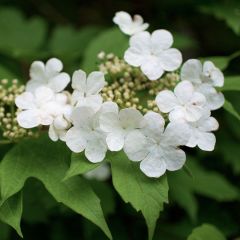
Guelder rose - Viburnum opulus
- Flowering time June, July
- Height at maturity 3,50 m
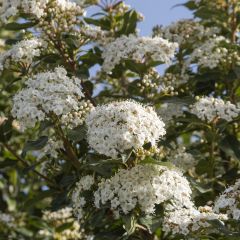
Viburnum tinus - Laurustinus
- Height at maturity 2,50 m
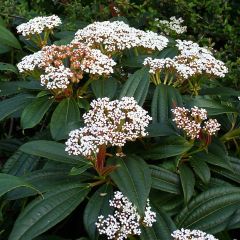
Viburnum davidii - David viburnum
- Flowering time July
- Height at maturity 1 m
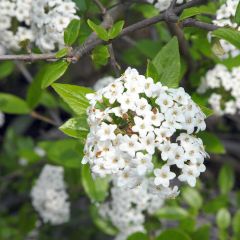
Viburnum burkwoodii
- Flowering time May, June
- Height at maturity 2,50 m
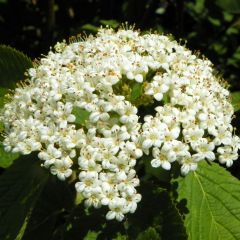
Viburnum lantana
- Flowering time May to July
- Height at maturity 3 m
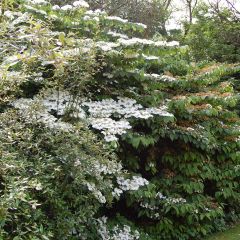
Viburnum plicatum Lanarth
- Flowering time June, July
- Height at maturity 3 m

Viburnum bodnantense Dawn
- Height at maturity 2,50 m
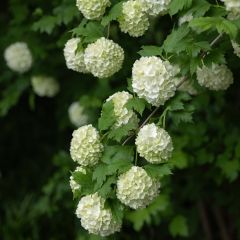
Snowball Viburnum - Viburnum opulus Roseum
- Flowering time June, July
- Height at maturity 3,50 m
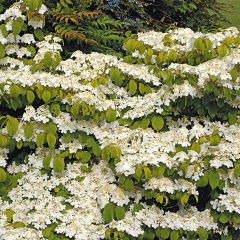
Viburnum plicatum Mariesii Great Star
- Flowering time June, July
- Height at maturity 2,50 m

Viburnum Le Bois Marquis
- Flowering time June, July
- Height at maturity 2,50 m
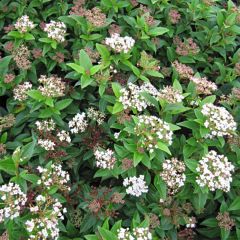
Viburnum tinus Eve Price
- Flowering time February to May
- Height at maturity 2 m
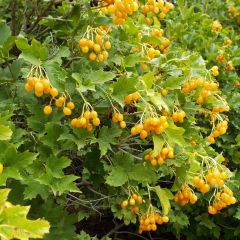
Viburnum opulus Xanthocarpum
- Flowering time June, July
- Height at maturity 2 m
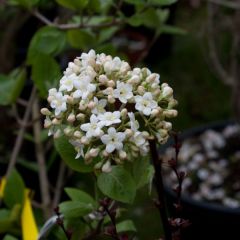
Viburnum x carlcephalum
- Flowering time June, July
- Height at maturity 3 m
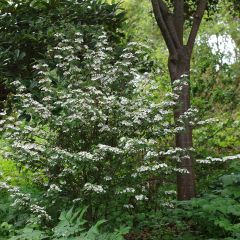
Viburnum plicatum Kilimanjaro Sunrise
- Flowering time June, July
- Height at maturity 1,60 m
To choose the right Viburnum, explore our guide: “Viburnum: Which Variety to Choose?”
Save
Save
Save
Save
Discover other Viburnum
Planting Viburnum
Where to plant?
Viburnums adapt to various soil types and can tolerate heavy, clay soils. Plant them in rich soil that remains moist in summer and preferably well-drained. When planted in light, deep soil, your Viburnums will be far less likely to fall ill, particularly from phytophthora! Avoid overly hot and dry locations (especially for Viburnum opulus), as well as waterlogged soils in winter! You can also improve drainage by adding gravel or clay pebbles during planting.
Most species prefer partial shade. However, some viburnums thrive in full sun, such as Viburnum tinus, Viburnum x burkwoodii, and Viburnum lantana.
Viburnums generally prefer neutral to acidic soils. Some, however, tolerate chalky soils, including Viburnum lantana, Viburnum tinus (Laurustinus), and Viburnum sargentii.
For evergreen species, choose a location sheltered from wind, especially if you live in a cold climate. Laurustinus, however, tolerates wind and sea spray well, making it ideal for coastal gardens.
Finally, some species can also be grown in large pots or containers. For this purpose, choose Viburnum tinus ‘Eve Price’ or Viburnum davidii.
Of all Viburnums, Laurustinus is undoubtedly the least demanding. It is easy to grow and adapts to various conditions, making it the perfect shrub for beginner gardeners!
When to plant?
Plant deciduous varieties preferably in autumn, in October or November. For evergreen varieties, which are more sensitive to severe winter frosts, early spring (March-April) is best.
How to plant?
Plant Viburnums in groups to encourage decorative berries! This will improve pollination and fruiting, especially for species like Viburnum davidii. Generally, you’ll get more ornamental berries if several plants are grouped together.
For hedges, space viburnums at least 80 cm apart from other shrubs, and 4 to 5 metres if planting as a standalone specimen. This gives them enough room to grow.
Add some ericaceous compost if planting Viburnum davidii. Unlike Viburnum lantana, it prefers acidic soils!
Start by soaking the root ball in a bucket of water to encourage establishment and make subsequent watering easier. Dig a planting hole two to three times the size of the root ball—this is crucial for root development. Add some soil and compost to the bottom of the hole, along with a few handfuls of well-rotted manure. Place the root ball, ensuring it’s not planted too deep: the root collar should be level with the ground or slightly above. Backfill with soil and firm gently. Water thoroughly. Stake the plant if needed.
Continue watering regularly for the first few weeks after planting. During the first few years, water during summer droughts to help the viburnum establish a strong root system and become more drought-resistant.
→ Also check out our guides: Growing Viburnum in pots and Viburnum pests and diseases
Save
Save
Save
Save
Maintenance
We recommend mulching around your viburnums to keep the soil cool during summer. However, Viburnum opulus and Viburnum x burkwoodii tolerate drought quite well. Mulching can also provide extra protection during winter.
Viburnums thrive in rich soil—they are quite hungry for nutrients. To encourage growth, apply fertiliser or compost every spring. Weed the area, then spread a few handfuls of slow-release fertiliser or a layer of compost (2-3 cm) around the base of the shrub and work it into the soil with a rake.
Viburnums are susceptible to several diseases and pests. They can be attacked by aphids, weevils, and the Viburnum Leaf Beetle (Pyrrhalta viburni). Vine weevils may also nibble on the leaves. Learn all about vine weevils.
They are also prone to black spot disease and honey fungus. Laurustinus (Viburnum tinus) is vulnerable to whiteflies, while Viburnum davidii is susceptible to phytophthora. (Find out more about diseases and pests affecting Laurustinus).
Discover how to prune viburnums in our tutorial.
Phytophthora and black spot disease are caused by fungi—avoid overwatering and add a layer of gravel or clay pebbles at planting time to improve drainage. To keep your viburnums healthy and disease-free—especially Viburnum plicatum, which is particularly vulnerable—plant them in light, deep, non-alkaline soil!
Pruning
Pruning viburnums isn’t always necessary. You may trim them to maintain a balanced shape and remove dead or damaged branches. Prune in spring, after flowering, on plants at least three or four years old. Light pruning is best for evergreen species. Deciduous varieties tolerate harder pruning and can even be cut back hard. We suggest pruning only when needed, especially if you want autumn berries—pruning after flowering will reduce berry production. Viburnums sometimes produce suckers or shoots from the base—remove these if they appear.
Viburnum lantana and Viburnum davidii respond well to light pruning, just to maintain shape and remove dead or misplaced stems. Viburnum x burkwoodii and Viburnum plicatum rarely need pruning. Laurustinus can withstand harder pruning, allowing for more formal shaping and controlled growth when planted as a hedge.
→ Learn more about pruning Laurustinus in our tutorial!
Propagation
You can propagate your Viburnum by sowing, cuttings, and layering. We recommend layering as it’s the simplest and quickest method. If you propagate viburnum, you’ll need to wait at least two years before planting it permanently in the garden. It’s also possible to propagate by digging up and transplanting its suckers—the new shoots that emerge from the ground and develop from the roots.
Sowing
We recommend cuttings or layering over sowing, as you’ll get beautiful plants more quickly. Propagating viburnum by sowing is a delicate operation that takes time. The seeds may take a long time to germinate (up to two years). However, viburnums sometimes reproduce on their own through self-seeding.
You can sow in autumn or in late winter from March onwards, under a cold frame. Generally, we advise harvesting the seeds in autumn and either sowing them immediately (after removing the pulp surrounding the seeds) or storing them in a cool place throughout winter for sowing in spring.
Some species, like the Guelder rose (Viburnum opulus) or Laurustinus (Viburnum tinus), require warm stratification (20°C) for one to two months, followed by cold stratification in the refrigerator for two to three months. This helps break their dormancy. Viburnum rhytidophyllum only needs a cold period of three months. You can then sow the seeds in spring.
To stratify the seeds, place a layer of sand in a tray. Position the seeds and cover with a second layer of sand. Then cover the tray with a plastic bag and place it in the refrigerator.
For sowing, fill a tray with substrate. Sow the seeds, cover with a thin layer of compost, and lightly firm. Water and place the tray under a cold frame. Keep the substrate moist until germination. You can repot the young plants in spring.
Cuttings
Take cuttings from viburnums in summer, from May to September. This process is easy to carry out.
You can take softwood cuttings in May or June (better for deciduous species like Viburnum opulus) or semi-hardwood cuttings from July to September (evergreen species like Viburnum davidii).
Prepare a tray by filling it with a mix of compost and sand. Water to moisten the substrate. Choose a healthy, young shoot. Cut a 10 cm section with a sharp knife, just below a node (where leaves attach to the stem). Remove the lower leaves if necessary. Plant the cutting and gently firm to ensure contact with the substrate. Keep the substrate moist. Two months later, you can pot the cuttings and overwinter them under a cold frame.
Layering
Layering is the easiest method to propagate Viburnum. Do this in early autumn, in September or October.
Choose a low, long, flexible branch and bend it towards the ground. Prepare the soil at this spot by loosening it, adding some compost, and digging a small trench about 10 cm deep. With a sharp knife, make a few shallow cuts on the underside of the shoot. Bend the branch to contact the soil at the incision point, cover lightly, and secure with a stone. Stake the tip upright. Water. Two months later, you can cut the branch to separate it from the parent plant.
Save
Save
Save
Save
Association
With its rustic and natural charm, the viburnum is perfect for creating a living hedge! Species with dense evergreen foliage, such as Laurustinus (Viburnum tinus) or Viburnum rhytidophyllum, will shield you from prying eyes even in the depths of winter. Pair them with Spireas, Photinia x fraseri, or Dogwoods.
For a romantic effect, combine Viburnum lantana with other soft-toned plants like Deutzias, Kolkwitzias, or Weigelias. And enjoy the fragrant blooms of Mock Oranges or Lilacs!
If your garden is small and space is limited, opt for species that thrive in large containers placed on a terrace: this is the case for Viburnum davidii or Viburnum tinus ‘Eve Price’. Plant a few flowers or ornamental grasses alongside them: Primroses, Grape Hyacinths, Hakonechloa macra, or Ophiopogon planiscapus.
If you choose Viburnum plicatum or Viburnum opulus ‘Roseum’, plant them as standalone specimens. Their exceptional structure and blooms will be showcased even more beautifully! You can also plant periwinkles, spring bulbs, or perennials at their base.
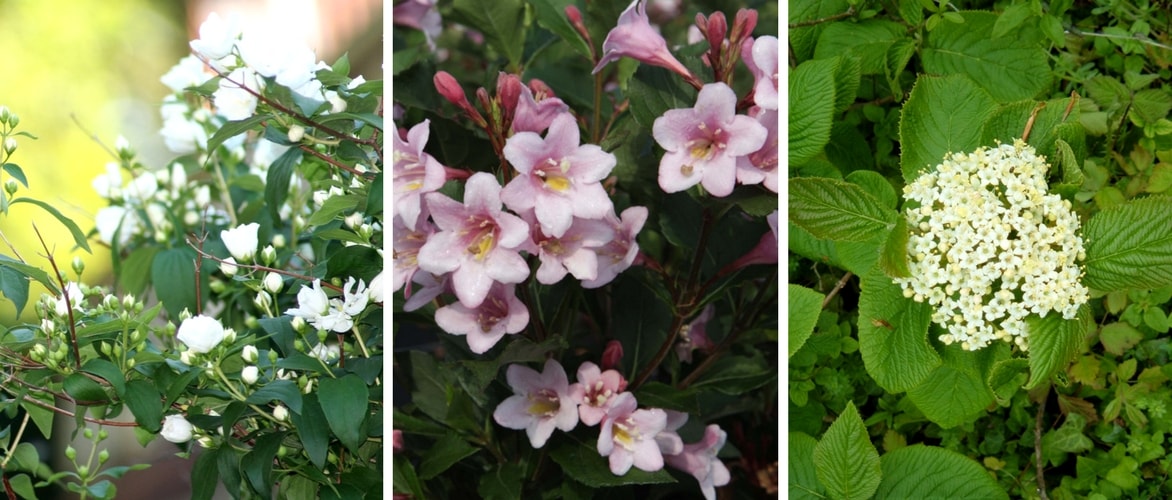
A planting idea: Deutzia, Weigelia florida ‘Polka’, and Viburnum lantana
Need a little more inspiration? Check out our planting guides: “Viburnum – 8 Successful Planting Combinations” and Pairing Laurustinus
Enregistrer
Enregistrer
Enregistrer
Enregistrer
Useful resources
- Our wide range of Viburnums
- Video – All about Viburnum tinus
- Guide – How to take cuttings from Viburnum tinus?
- Tutorial: How to create a Viburnum tinus hedge?
- Discover 6 evergreen viburnums; 5 viburnums for creating hedges; 7 viburnums for small gardens or container growing
- Planting guide Planting perennials and shrubs
- Article by Didier Willery, published in L’Ami des Jardins et de la Maison: Viburnums, a Spring Avalanche!
- Video: Viburnum ‘Winton’
- Video: Wayfaring tree (Viburnum lantana)
- Video: Viburnum tinus, a four-season shrub
- Video: Viburnum bodnantense, a fragrant winter-flowering shrub
- Video: Viburnum hillieri ‘Winton’
- Discover 7 trees and shrubs with tiered branching
Frequently asked questions
-
My viburnum isn't growing!
After planting, viburnums need time to establish themselves and begin growing. Be patient if you've recently planted yours. If your viburnum isn't growing, it could also be a sign of nitrogen, phosphorus or potassium deficiency. Apply slow-release fertiliser or compost in spring to encourage growth. Laurustinus is one of the slowest-growing species. It's perfect for small gardens (especially since it tolerates hard pruning)! Viburnum rhytidophyllum and opulus grow much faster.
-
My viburnum isn't flowering!
This could be due to an excess of nutrients and nitrogen-rich fertiliser: they promote vegetative growth at the expense of flowering. Cut back on feeding! Also check that the growing conditions are suitable. Too shady a location will limit flowering. For reference, viburnum prefers to be planted in partial shade or full sun, in cool, well-drained soil. Finally, if you obtained your viburnum from seed, be aware that it may take several years before you see it flower.
-
My viburnum is losing its leaves! What should I do?
If the leaves fall in autumn, there's no need to worry! It's seasonal... If this happens at another time of year, or if it's an evergreen species, your viburnum is likely planted in too dry a location. Water it and apply mulch to maintain soil moisture. Viburnums are sensitive to summer drought, especially during the first few years!
-
The leaves on my viburnum are wilting and curling up on themselves!
If the leaves of your viburnum appear curled, this is likely due to black aphids. Inspect the plant and look for the presence of aphids and ants. Spray with a solution based on black soap or nettle manure.
-
There are black larvae on my viburnum! What should I do?
These are most likely viburnum leaf beetles (Pyrrhalta viburni). They skeletonise the leaves, leaving only the veins. Examine the leaves carefully: if they are damaged in this way, manually remove the larvae and any leaves bearing eggs. Spray with a natural pyrethrum-based insecticide or a solution containing black soap.
-
My viburnum seems to lack water even though the soil is moist!
If your viburnum appears wilted and its leaves are drying out, it is likely suffering from phytophthora. This disease attacks the roots and prevents them from absorbing water and minerals. Consider relocating it to a light, well-draining soil, as stagnant moisture encourages the development of this disease! If it's a compact variety like Viburnum davidii or Viburnum tinus (Laurustinus), grow it in a container.
- Subscribe!
- Contents



































